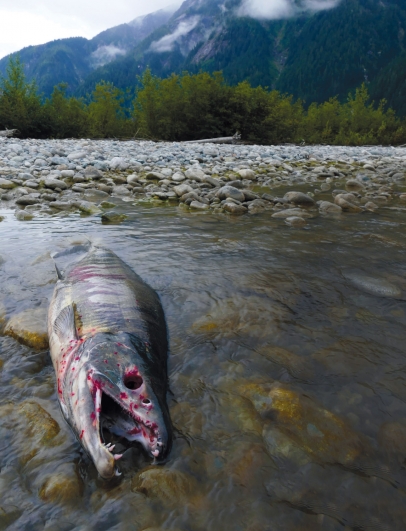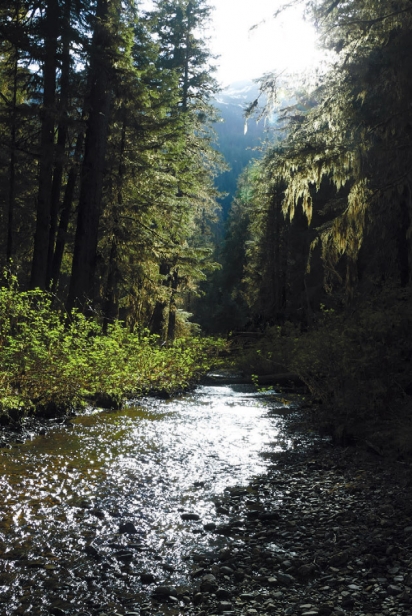Salmon in the Garden
Last fall, my partner MC and I bought a house near the Mendenhall Glacier with big garden beds in the backyard. It had been a long while since the beds were tended. Hidden in the forest of weeds were artistically painted signs with the names of vegetables planted years ago. There were gardening tools, seed planters, and grow lights in the sheds. Whoever lived in the house had invested a lot of care and energy in growing their food. Neither MC nor I knew much about gardening. Now, it was up to us to bring the garden back to life.
Behind the garden plot are woods and a trail that leads to a stream where, as we explored our backyard for the first time, a small run of coho salmon was spawning. Our two-and-a-half-year- old son watched, mesmerized, as salmon jockeyed for position while our six-month-old slept on my back. I was struck by the similarities between salmon spawning and gardening. Salmon dig gravel nests, called redds, to “plant” and “fertilize” their eggs. Sediment, temperature, and other environmental elements have to be just right in order for eggs to hatch and for salmon to grow.
Some of my earliest memories are of hundreds of pink salmon spawning in a creek on Admiralty Island. The forest and a wall of salmonberry brush towered above me. Eagles carrying the flesh and guts of salmon in their talons winged through the maze of trees. Partly eaten carcasses lay strewn over gravel. Ravens, seagulls, and other birds pecked at eggs and guts. Brown bear tracks lined the bank. The visceral hold bears’ presence had on me then hasn’t changed much 35 years later. I watched my older boy staring at salmon and wondered what memories he’d count as his first. After a half-hour, I tried to get him to leave. He threw a tantrum but took solace in my promise we’d come back soon to visit the salmon.
Fall is harvest season in Alaska. I’d been away for almost four months guiding natural history film crews after brown bears and our freezer was nearly empty. My brothers gave us a number of king and sockeye, but we needed more salmon for the winter. There were cohos schooling up on the nearby Mendenhall Wetlands. When the tide was right, I slipped away and fished until we had enough for the year to come. Some I’d smoke, some would be baked, blackened on cast-iron, or grilled. I saved the carcasses to put in the garden beds as fertilizer after the majority of bears had denned for the winter. Once we added a few deer to the freezer, I began working on the garden. My son “helped” pull weeds, pick out rocks, and turn the soil. My dad helped plant garlic. While I gathered seaweed to put on the beds, my son played with salmon bones, pretending they were dinosaur bones.
The pink salmon run had been decent in the streams on Chichagof Island I’d been guiding that August. On one “average” stream, I estimated there were around 30 different brown bears utilizing the first mile. Each bear—besides cubs—was catching up to 30 or more fish a day. They didn’t eat all of the fish, though. The remains, along with bear scat, were scattered through the forest, fertilizing trees and plants, and feeding multitudes of invertebrates. Some studies show that up to 70 percent of nitrogen found in foliage in riparian areas comes from salmon. Trees along salmon rivers tend to grow much more quickly and larger than trees along rivers without salmon. Bears are responsible for spreading the salmon. This “salmon forest” in turn enriches and protects the stream, grows multitudes of important species of invertebrates that’ll feed young salmon, and optimizes the quality of spawning and rearing habitat. Salmon and the forest are so intertwined that it inspired the phrase “salmon in the trees,” popularized by author Amy Gulick who used it as a book title.
I began paying better attention to salmon 15 years ago when I was working as a deckhand on a commercial troller. We only wanted coho and kings, so most days I’d release 500 or more pinks. The following season, there were significantly fewer pinks to shake from our gear. The next season there were hardly any to let go. Not long after that I began guiding photographers and natural history film crews after brown bears. At first there were schools of pinks darkening the ocean shoreline and creeks would be packed. Then, those massive schools thinned out. The big runs of chum salmon started to vanish. We didn’t see one chum during the month-long film shoot in August. Five years earlier, the same watersheds had significant numbers of chums spawning. I kept telling myself they’d come back, but now I’m not so sure anymore.
At our new house by the glacier, my family would periodically return to the creek near our home to see what the salmon were doing. By late October, the last of them were half-dead, scale-less, and covered in lesions. I had a humbling realization that every salmon in our freezer, even the fish my brothers had given us, was a hatchery fish from terminal runs, meaning the salmon would die in saltwater without spawning or giving back to the stream and forest ecosystem. It was during the first snows of the year that we went to the creek and couldn’t find any salmon. All but a few bears were in their dens beginning their dream journey through winter.
One of the last things I do each harvest season is render broth from all the bones of deer and animals taken that fall. That year we had five bucks which would make a little less than four gallons of broth. The stuff is liquid gold and never lasts as long as we’d like it to. I covered the bones in water in a giant pot, added some celery and yellow onions, then let it simmer overnight. In the morning, I removed the bones and gristle, then put them in my backpack to return to the woods. Before leaving, I pulled out a garbage bag full of salmon parts and left it to thaw. I hiked the deer remains well away from the beaten path, up where a stream turns into a waterfall tumbling down a mountain. The salmon runs around our home came into existence as a result of new habitat forming when the Mendenhall Glacier receded. As small as these runs may be, they gave me some hope. I dumped the deer bones and scraps along the stream. I said my last thanks to the animals that had become my family’s food and began the hike home.
When I got back, I emptied the bag of salmon heads and carcasses and chopped them into pieces. My older boy helped scatter the pieces into the dirt of the garden beds. I nailed tarps and plastic sheeting over afterward, to insulate them for the winter. The rain was switching to snow as I stepped back to survey the plot. I had much to learn, but I imagined all the good things that would grow here with a little energy and care. My boy called for my attention. He’d found a halved salmon head we’d forgotten and was holding it up to me.
“Is this food?” he asked.
“Yeah, for our garden. We’ll eat a different part of the salmon tonight,” I told him.
I lifted a corner of the tarp on one of the beds and we planted the piece of salmon into soil.
Published in Edible Alaska issue 24, Summer 2022.













